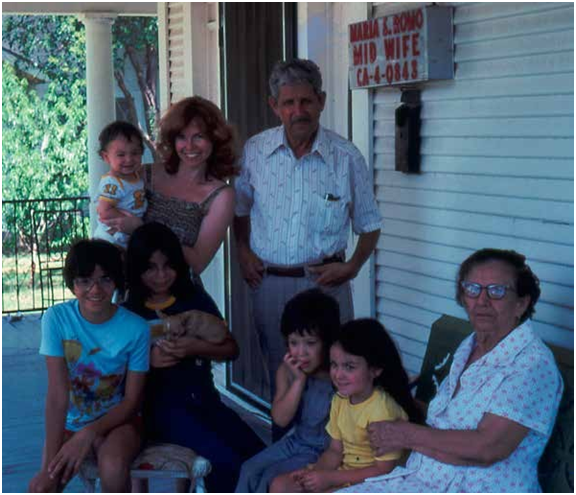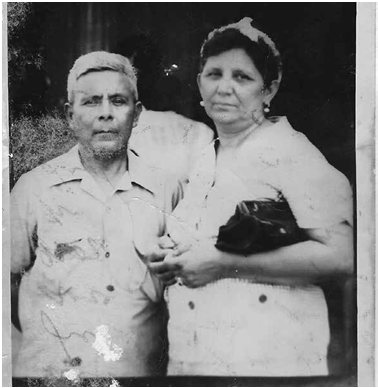By Dr. Ricardo Romo
San Antonio’s social and cultural history has been enriched over the years by its many Latino neighbor- hoods. Many of them date back to the World War I era of the 1910s. From 1910- 1940 most Latinos lived in the Westside, a community that extended from the Missouri Pacific Railroad yards to San Fernando Cemetery #2 on Castroville Road. The boundaries on the south ex- tended to Frio City Road and the community spread north to Culebra Road.
This is an essay about the evolution of Prospect Hill, an early ethnic neighbor- hood initially comprised of residents from German and East European background. I lived in Prospect Hill and witnessed first hand much of the Latinization of “Anglo” Prospect Hill.
The Sosa family were pioneers in the movement of Latinos to Prospect Hill. Roberto Sosa married Cristina Jimenez in 1938, the same year that he opened Prospect Hill Cleaners on Commerce Street. At that time he was only 21 years old. The clean- ers were two blocks from my house on Monterey Street and in the 1950s, we often saw Lionel and his brother Robert Sosa when we stopped to drop off or pick up clothes at the cleaners.
Prospect Hill Cleaners was at the heart of the commercial district of Prospect Hill. The family-owned business was across the street from the original David Crockett Elementary school and near the fabled Walter’s Drug Store. The cleaners were also only a few doors from a popular feed store and Winn’s variety store.
Lionel Sosa was born in family quarters located be- hind the cleaners. He at- tended Lanier High School and upon graduation from high school he went into the advertising business and eventually opened his own company with offices down- town. His dad remained in the cleaning business, which every year became more competitive. As large cleaners began offering lower prices and pick-up service, Prospect Hill cleaners closed its doors in the early 1960s
Prospect Hill extended from the Alazan Creek to Hamilton, just west of Zarzamora. The boundaries of the old Anglo areas of the neighborhood were clearly defined–Durango Street on the south and Travis Street to the North.
When the Centeno Grocery store opened in Prospect Hill in 1948, the Centeno family were following the path of Sosa and several other Latino entrepreneurs. Jose Centeno, a Laredo native, came to San Antonio in 1914 and worked in a dry goods store. He learned the grocery business and in 1928 he opened a small store on Rivas Street, part of the northwest section of the Latino Westside. Business was good, even during the Great Depression years. In the mid-1940s Centeno began looking for property in Prospect Hill.
The Centeno store on Commerce Street was one of the largest grocery stores in the city with parking for 500 cars. Centeno, with its large meat department, bakery and fresh produce, attracted La- tino customers from through- out the Westside. Their proximity to the Alazan-Apache Housing units also made shopping easier for the 1200 families living in the courts. Centeno eventually opened four other stores, including a giant store on Castroville Road near 24th Street. Jose Centeno trained his two sons, Joe Centeno Jr. and Eloy Centeno to manage the business. From 1948 to 1970, the Centeno family rose to the top of most successful Latino businesses of San Antonio.
Prospect Hill also had numerous Latino-run restau- rants, none more popular than the Paul Marie. The idea for a drive-in restaurant with carhops came to Oscar Ro- driguez Sr. when he landed in California as he returned from World War II. He tasted a crispy dog in California and concluded that it would be a popular dish in San Antonio. He was right.
According to Paula Allen of the Express-News, Paul- Marie had been a tavern in the 1930 and 1940s. When Rodriguez opened the new Paul Marie in the late 1940s, he added carhop service and the crispy dog. Soon after his grand opening, Rodriguez met Zulema, one of his carhops. They married and moved to Saunders Street, one block north of his Durango Street restaurant. He lived not far from Pete Cor- tez, founder of the Mi Tierra restaurants.
In its twenty-year existence, Paul Marie was a popular hangout for Lanier High School students as well as for those attending Central Catholic. It is likely that Hope Andrade, former Texas Secretary of State, who also lived on Saunders Street, would have eaten a crispy dog there or would have spent a few leisure moments there as a teen.
For nearly 100 years, Commerce and Buena Vista Streets have been the main thoroughfares of Prospect Hill. From its founding at the turn of the century to 1960s, Prospect Hill had many prominent residents, including state and local politicians and millionaires. Carol Burnet, a Hollywood movie and television star in the 1950s, grew up on Buena Vista Street and attended Jefferson High School.
II. The Romo Family Odyssey In Prospect Hill In the post-World War II years, Latinos began to move out of the West side into neighbor- hoods that were ethnically different. When my parents moved to Prospect Hill in 1950, they were following a path opened by my dad’s mother, Maria Saenz Romo. We called our grandmother Abuelita Romo. She was the matron head of the Romo clan. She began the move north across the dividing line of Durango Street in the late 1940s. It was a planned move.
Abuelita Romo arrived in San Antonio in 1916, just in time to prepare for the birth of my father Henry Romo who was born in early 1917. She and her husband Benito Romo came to San Antonio via the cotton fields of Kyle, Texas where they had been employed as farm workers. After the birth of my dad, my grandparents decided to make their life in San An- tonio and moved to El Paso Street.
In a very good way, my grandmother was clannish. She loved being close to her family and somehow con- vinced everyone she loved to live close by. For this essay, I consulted with some of the 38 Romos who lived within two blocks of one another in Prospect Hill.

After moving to El Paso Street, which is part of the Guadalupe Street district, Abuelita Romo helped re- locate her mother to her neighborhood. By the early 1940s when my parents got married, Abuelita Romo lived across the street from one brother and sister and down the block from her mother and older brother. By the 1950s, all the Romos had moved north to Prospect Hill.
The entrepreneurial spirit in the Romo-Saenz families made possible the move north to Prospect Hill. Abuelita Romo learned her profession– the art of delivering babies– from a seasoned midwife. It was indeed an art and few gained the skills needed to be successful in such a delicate health profession, and one of the oldest professions for women. In my grandmother’s era, few families on the Westside could afford hospital stays because of the medical costs. Doctors seldom delivered babies in the Westside.
In Abuelita Romo’s era, there were dozens of mid- wives living and working in the Westside of San Antonio. I have been told by many who worked with my grand- mother or after her, that she was one of the best in the city. When I was in my twen- ties and I applied for a copy of my birth certificate, I was told by a city officer that my grandmother had delivered thousands of babies in the Westside.
My grandmother worked as a midwife for nearly 50 years. She trained my moth- er’s sister who delivered me. Aunt Julia also delivered several of my brothers. Abuelita delivered all twelve of her youngest son’s children and most of her siblings’ children.
When Abuelita Romo bought a home on Saunders Street, my dad fol- lowed with the purchase of a home a block away on Monterey Street. Abuelita Romo bought a second home on Saunders, where her oldest son Benito Romo moved in the late 1940s. Soon another of her sons, Arnulfo Romo, moved across the street from her, as did her daughter, Yolanda. Three dozen Ro- mos eventually lived within two blocks from my grand- mother’s house and that of my parents.
The Romo family move north across the dividing line of Durango Street was only five blocks, but to me as a seven-year-old, it appeared to be a move of many miles. When we arrived in our new home on Monterey Street there were only a few Latinos on each block. To the west on our street lived the families of former San Antonio city manager Alex Briceno, former San Antonio mayor Henry Cisneros, and the famous San Antonio artist Jesse Trevino. They all grew up on Monterey Street. Ethnically, Prospect Hill changed in the decade of the 1950s. While several of our Anglo neighbors left for the suburbs, a few Anglo teens who remained on our street became lifelong friends. By the mid-1960s the Latinization of Prospect Hill was nearly complete. My elementary school, Sacred Heart Catholic School, had some Anglo students, but not many after 1960. All my memories of growing up in the Prospect Hill neighborhood are good. Today Prospect Hill is over 90 percent Latino. I enjoy returning to my old neighborhood even though only a few Romo families still live there and many of the old family businesses are gone, replaced by national fast- food franchises.









